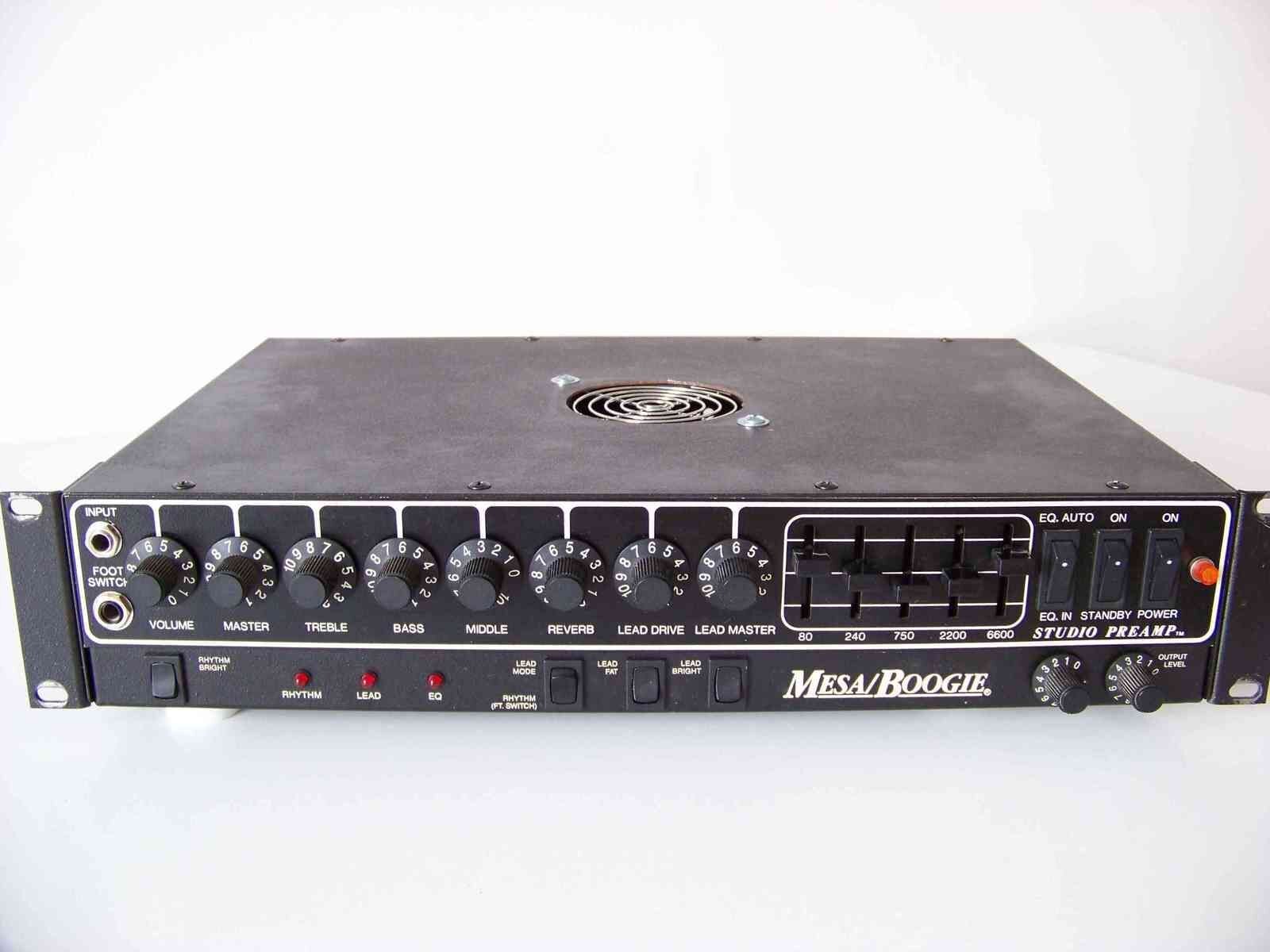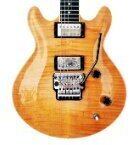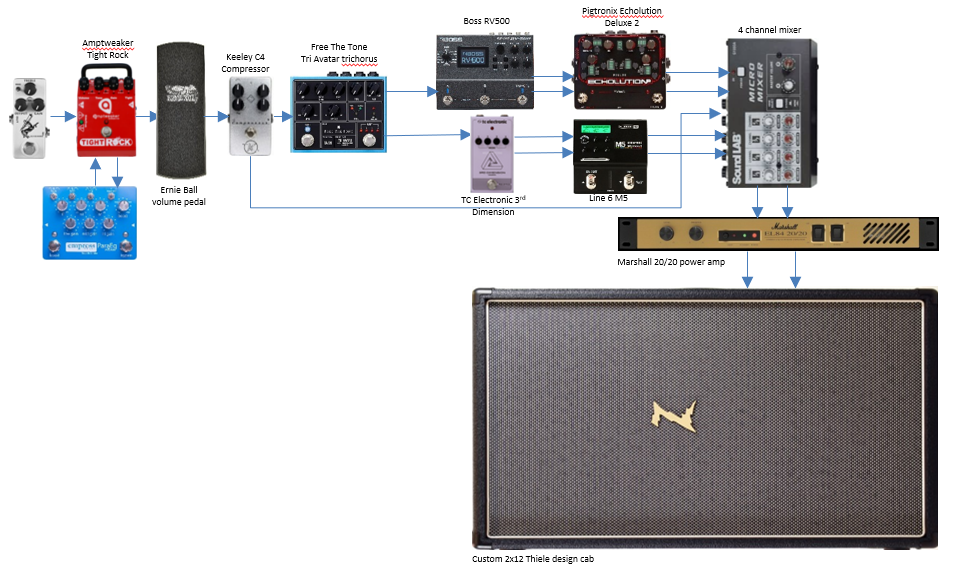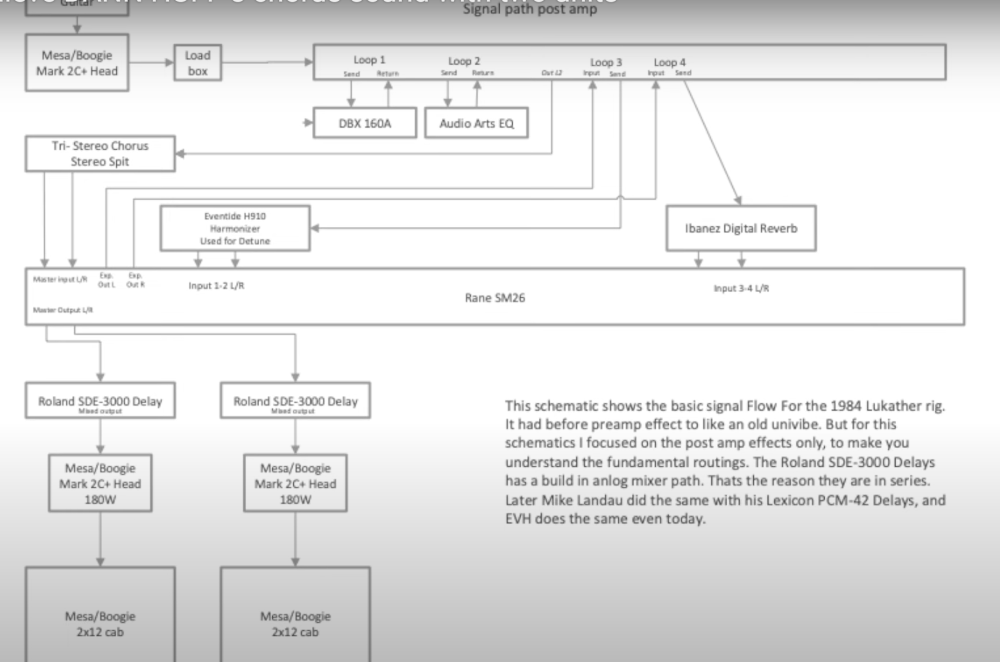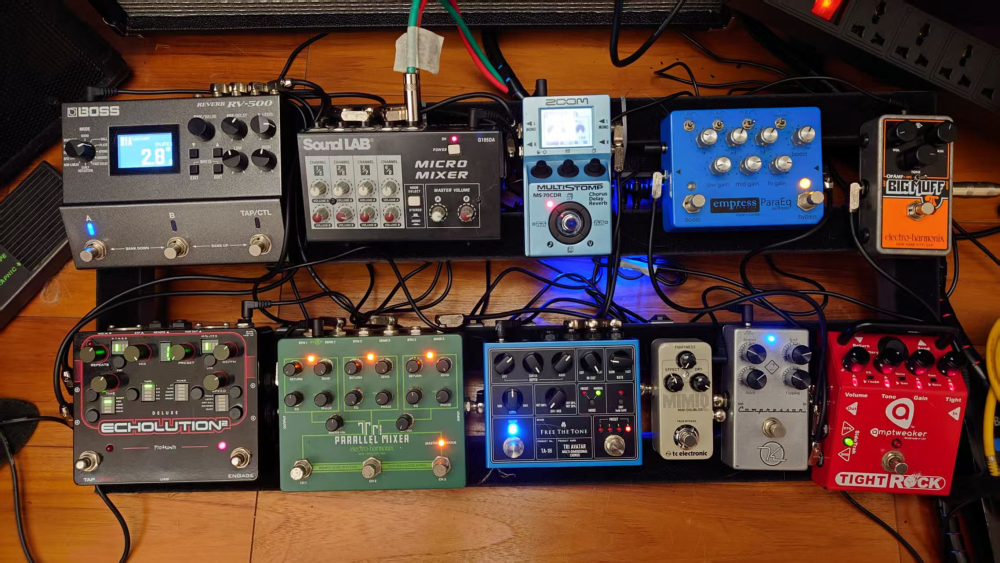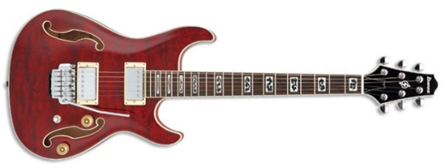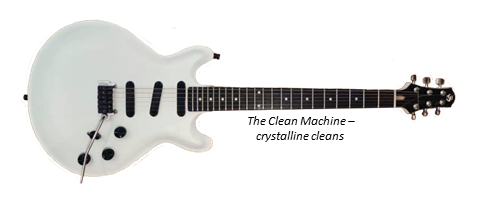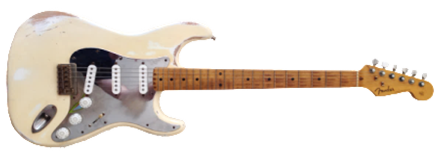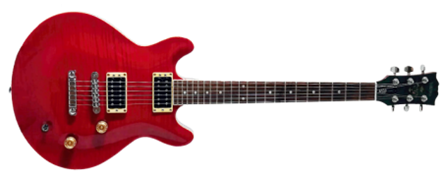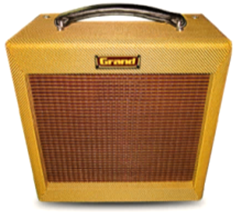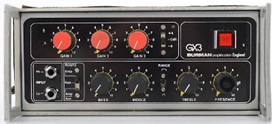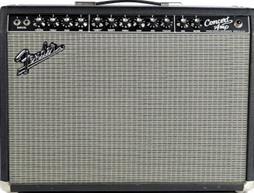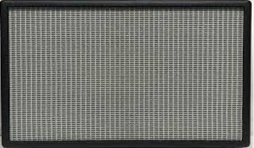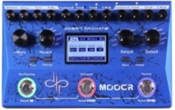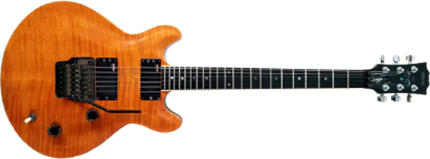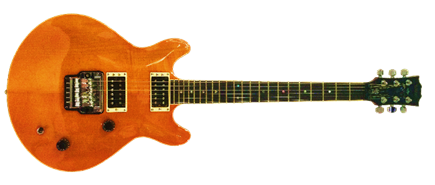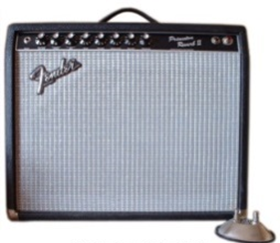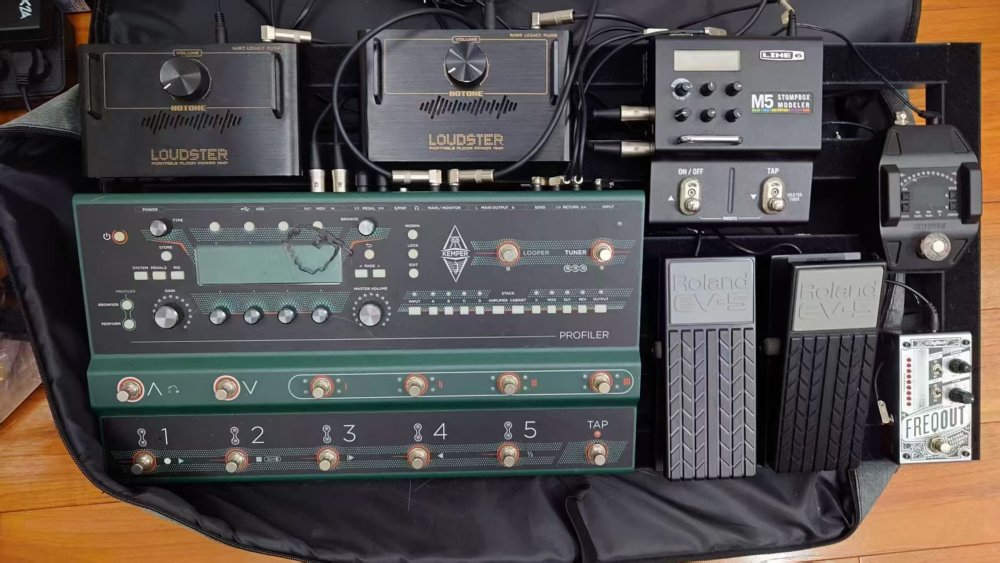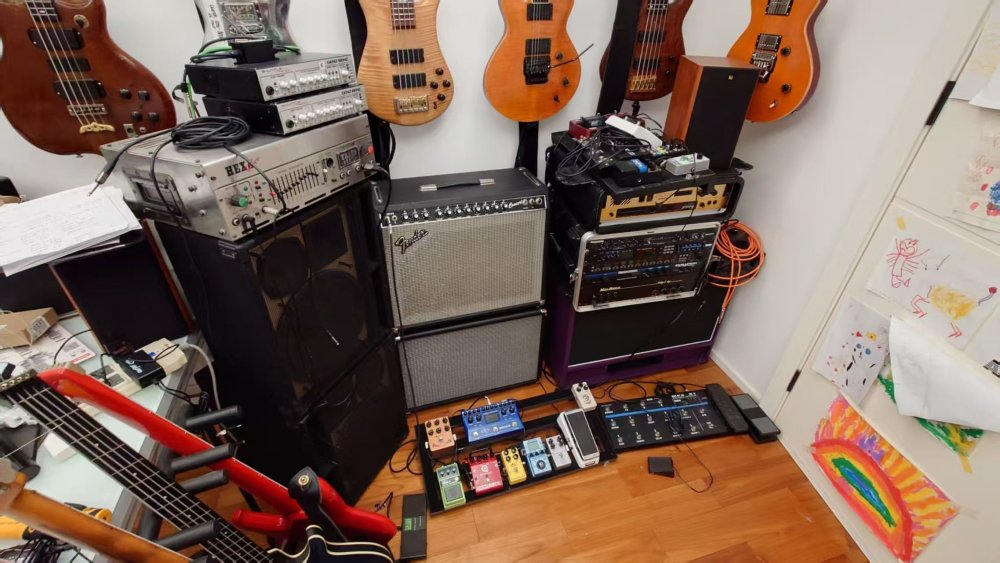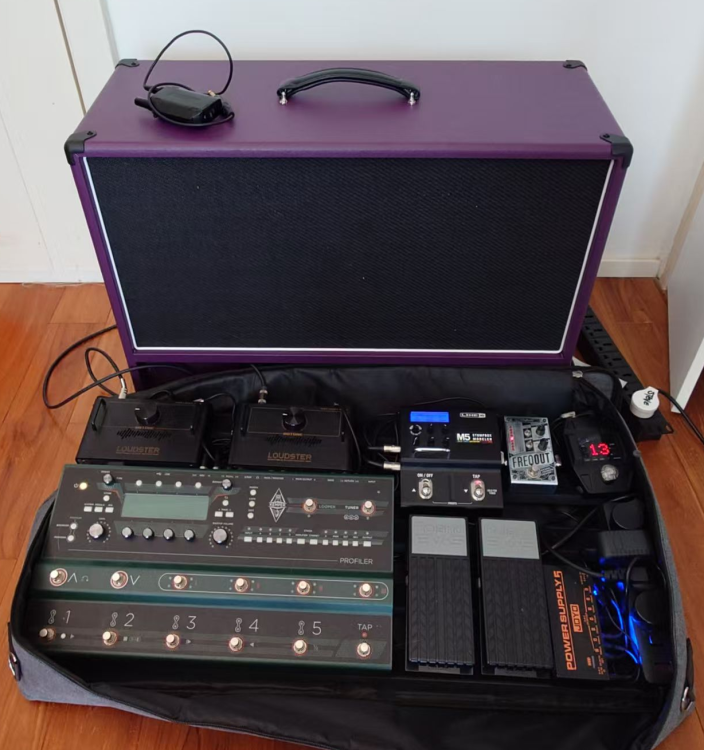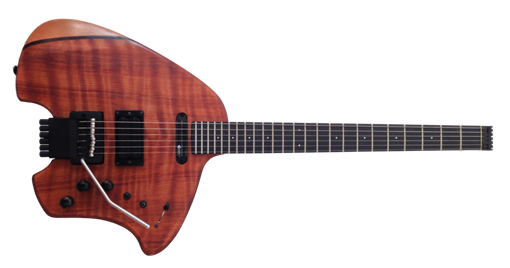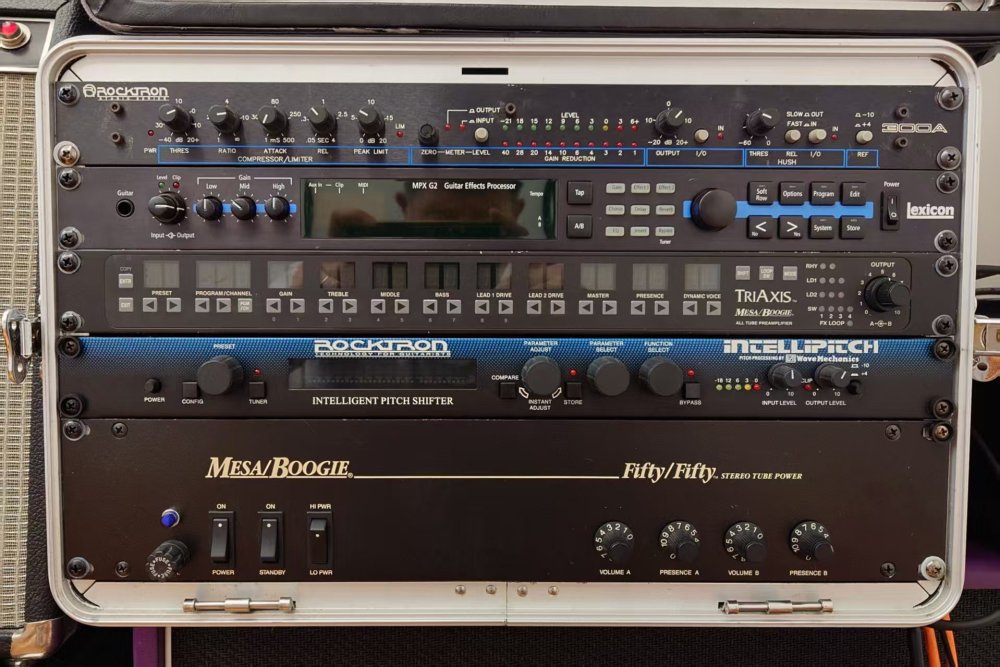Right, let's try that update again now the server is back up.
So there have been a lot of purchases in the last five years mainly due to the sale of a business venture. It's been a lot of fun trying out different gear as you do but reality is starting to bite and I'm running out of space!
Guitars:
Ibanez AWD83T: In the original post above, I mentioned an Ibanez AWD82 and a few months back I snagged an AWD83T (with trem) on a japanese auction site for a couple of hundred quid plus shipping. It must have been part of an estate sale because it arrived sticky with nicotine stains and rusted strings. However after a bit of cleaning up and new strings, it's a total honey. The factory installed bridge pickup sounds tight and mean when cranked. The bridge pickup could be a little mellower but it still sounds jazzy and the neck is straight as an arrow making for low action. Can't recommend these guitars enough. Sounds better than the Yamaha SAS II I also had my eye on (basically the semi hollow version of the MSG/Image).
The Clean Machine: Over the summer two years ago, I took a week out with Jon Shuker to build a body and install the electronics I had been hoarding for a guitar that is intended to satisfy a curiosity about the Aria RS Esprit that was made famous by Alan Murphy and Yngwie Malmsteen in the eighties. It featured Alembic licensed bridge and neck pickups and low pass filters plus a boost feature. I bagged a set of three genuine Alembic Activators off Reverb for 150 quid a few years back and Nuno at Lusithand deserves a huge shout out for customising a set of his DLPF circuits for guitar (and his customer service follow up is nothing short of outstanding as well). Not wanting to rest on my laurels, some Graphtec piezo saddles were installed on the Wilkinson VS100C trem and connected to a Ghost Acoustiphonic preamp. A rotary selector switch was needed to select between 5 pickup positions and the piezo. It still didn't deliver quite the sparkle I was looking for and I theorised it might be because the soft neck wood was dampening some of the higher frequencies. So more recently I had a custom graphite neck commissioned from a guy I know in China and installed it last weekend, it provides more sustain and a more pleasant bell like chime to notes, definitely gets me closer to where I wanted things to be but still lacks a certain something of the original. The really interesting thing is the impact that the filters have on the timbre of any overdrive or distortion, it's surprisingly versatile for recording at least and it's possible to get lots of interesting and not unpleasant sounds when messing about. The sensitivity of the filters make it a little impractical for live use though.
Al Knight Hitmaker replica:
As much as I like this guitar, it's sort of paid its dues and my tastes have moved on since. So it'll be up for sale over here at some point in the near future. Plays great and sounds exactly like Nile's guitar on the first Chic album.
Yamaha MSG Deluxe #1: This was the first MSG I purchased, it's a transition model has the Mach 2 headstock but Mach 1 control locations. It's a little lighter and brighter than number three and in better condition. Not quite as smooth sounding and doesn't have quite the same depth of flame in the top but it's still nice. In a pinch, I would put it up for sale though to make room for other toys...and probably have sellers remorse as a result.
Yamaha MSG Deluxe #3: Bought a long time ago, it was the third MSG purchased off Ebay (I think). Number 2 was a sunburst deluxe that was ultimately sold because it was light and bright sounding. This one by contrast is smooth sounding but with a nice midrange punch, even more so after installing my favourite Armstrong pickups so it will do rock and jazz with a flick of the pickup selector switch. Unfortunately the fine tuner screws started wearing out in the proprietary RM Pro trem and the only available replacement bridge chassis was black (off an RG). I actually prefer it in black.
Yamaha MSG Standard #4: Originally I bought this because I wanted a simpler guitar and wanted to see how much of an improvement a tune-o-matic style bridge might make to the sustain. I picked it up for cheap because it was in desperate need of a refret and fingerboard dressing. So I took out the frets, carefully reradiussed the 13" radius fingerboard to a slightly flatter 12"radius and installed new frets. As it turned out, the bridge didn't make a whole lot of difference however, I installed some PRS Mira pickups in and it's an outrageous, raw rock machine when paired with the Marshall rack gear. However it may go up for sale in the medium term as the lack of a belly chamfer makes it uncomfortable to play sitting down and while it does rock really well, other guitars can fill the same niche even in a slightly different way and offer more versatility.
Kleinberger: I've completely changed my mind about this guitar after trying it through the Marshall rack! While it may not have the most scintilating cleans, when it's cranked there's a real girth to the midrange that punches well above it's relatively small (but wide) size. However, I have another build with a sustainer planned so may let this one go at some point...after I've sorted out a case for it.
Rig 1: Guitar rack:
This will do pretty much anything from mid eighties onwards. It sounds tight, modern, smooth and well defined. It can do practice volumes as well as performance.
Rocktron 300A compressor: This was my first piece of Rocktron equipment and it got broken before I had a chance to try it when a friend plugged in the wrong power supply (it takes AC not DC). So the power caps were replaced and it works fine now. I found it needed some careful dialling in and it sounds OK but not quite as clean as the DBX. However it sits ahead of the Lexicon MPXG2 in the guitar rack now so it does the job it needs to. I probably need to spend more time with it dialling it in.
Lexicon MPXG2: I've had two for DECADES and I love them, especially with the R1 foot controller. The only thing on the market that comes close and then offers slightly more versatility with the extra loops is the TC Electronic G system. The MPXG2 was way ahead of its time; the effects chain and routing can be configured at will into parallel, left and right signal paths and in any order. The only limit is processing power, so loading it with compressor, detuning, wah, chorus, delay, and reverb probably isn't going to swing. I took the R1 into my tech earlier this year, and he replaced a lot of worn switch contacts and reconnected the slave power through the 7-pin DIN cable, so now it's as responsive as new.
Mesa Boogie Triaxis preamp (x2): One v3 with the v1 British mod in Lead 1 red and the other is slightly older V2 and a little more worn membrane front but it has the recto board which gives recto tones in Lead 1 red. The MkIII (Lead 2 red) is the sound that has been in my head ever since I started learning guitar so both are staying put for the foreseeable future. Just amazing pieces of kit, there's not a bad sound in either of them.
Rocktron Intellipitch: Given the limitations of the Intellifex XL (see brelow), I bought this purely for its modulation including 8 voice chorus. It's a fairly rare beast, not many were made - certainly not as many as the Intellifex. Again, like the Intellifex, it lacks a certain sparkle so best suited to parallel signal chains rather than in series, but I have taken all of Leon Todd and others' tri-chorus settings and manually programmed them in.
Mesa Boogie Fifty Fifty power amp: I did a gig dress rehearsal with the Marshall 20/20 and it wasn't quite loud enough, so ended up getting a Mesa Boogie Fifty Fifty for about half the price of a 2:90. It almost makes the 20/20 redundant for practice due to it's high (50w) and low (15w) power settings and sounds a little smoother. But it's a lot heavier so I don't know how much of a practical improvement it actually offers.
Joyo 112V cabs (x2): Currently loaded with Celestion Neo Creambacks (which aren't available in China), I'm using these with the Kemper pedalboard at the moment but I'm tempted to put the V30's back in as I'm not planning to gig them in the future since getting the Thiele cab made. So the lightweight Thiele cab will stay with the rack and the Joyos with the Kemper pedalboard but the Thiele cab will be gigged regardless of whether the Kemper or the rack comes along too.
Rig 2: Vintage
I like to use this for songs before the mid eighties. Eagles, Toto etc.
Pedalboard
Xotic XW1: I originally bought this instead of a Crybaby because it didn't produce a volume drop when disengaged and it can be tweaked to sound like other wah pedals using the tone and Q controls. After I got it, I learned it was a favourite of Paul Jackson Jr and this year, Steve Lukather has been using one with Toto. At the moment I have it set up based on Paul Jackson's settings from one of his YT videos about the pedal.
Keeley C4 compressor:
This has replaced the Effectrode simply because there is no power bank available on the market that I can run the Effectrode off, so it always needs to have it's own separate power supply and that's really too inconvenient for live use. I did have a Joyo Dynacomp in place before but the footswitch was too noisy and there was some crossleakage under high gain. The Keeley is well made, it fattens and squashes the signal without sounding too intrusive. There are a lot of different kinds of comps on the market designed to appeal to many different tasts but I have no regrets buying this one. Initially I had it in front of the gain pedals but I may just experiement with putting it after.
Xotic AC Booster:
I had been playing around with various cheap TS and Klon style pedals as boosts into the Amptweaker but while they all fattened and articulated the mids nicely, they were a little flat sounding. So I bought the AC Booster and as soon as I plugged it in, there was some extra harmonic saturation that I had never heard before. It sounds good with the Concert II but really shines when pushing the PRII, the saturation from both seems to synergise into this rich mid range with some lovely thick harmonics and the tone controls allow tweaks to taste. I know some keep the drive below 12 o'clock but I've found that around 1-2 oclock delivers more saturation.
Nobels ODR1:
I got this pedal to trial but fell in love with how articulate it stayed even with higher gain settings. No wonder it's the favourite of producer/guitarist John Shanks. It also has very juicy levels of harmonic saturation which is enhanced when boosted with the Xotic AC booster. I almost prefer the combination to the sound of the Tight Rock. And into the PRII this combination sounds even better.
Amptweaker Tight Rock:
See above. Still my favourite high gain pedal. It's not subtle but does plexi and 6505 with almost no noise.
Crowther Hot Cake: This was inexpensive and I was really curious about how it sounded after seeing PRS use one. It's sort of half way between fuzz and distortion with a really grungy character if you push the gain into meltdown terrirtory. But back off and it's a very thick and warm fuzz/overdrive. Mine is from the mid noughties so has all the blueberry switch and different options for selecting different versions in previous runs. This one tends to swap places with the Joyo.
Joyo American Sound JF14: I mentioned above how good this pedal is and I ended up with two but only really use one. I keep coming back to this one, there isn't a lot out there to beat it apart from the pedal it copied - Tech 21 Blonde. It can do astoundingly god versions of Twin and Deluxe amps and when the mids are pushed using the character, mid eq and drive it will get near Super Champ. Just a great pedal but the components aren't as durable as they could be.
TC Electronic MImiq: This is a recent purchase with a view to starting the yacht rock board. Basically it replicates the sound of double tracking using two signal paths with one subtly affected by variations in delay and microtuning. I haven't played around with it much yet so don't have a lot to say about it yet.
Zoom MDC70: This was a cheap way to access a trichorus sound. It has a patch that copies a TC Electronic Corona tri chorus setting. It's possible to add two more patches for a total of three accessed with a single button press. I don't have a lot more to say about it at this moment but I'm temped to see how well it can cover the trichorus+micro detune that was made popular by Mike Landau and his frdge of rack effects in the eighties.
Mooer Ocean Machine mk 1: There's not a lot out there which can compete with this in bang for buck. The delays are pretty good, the reverb has an artificial sounding presence and I generally turn the shimmer control to zero which kind of reduces the transparency as well. Still, it's not likely to be noticed in live settings. A mark 2 version has been released which updates the algorithm and improves the effects quality but I haven't checked out whether the shimmer is better.
Once finances permit, I have plans to overhaul the pedal board and make it more schmoo focussed. So the drive pedals will probably stay but the delay and reverb will be handled in one signal chain by an Eventide Time Factor and Strymon Big Sky, and modulation in another a Free The Tone Triavatar and a Yamaha Magicstomp for SPX90 style detune.
Fender Concert II + 1x12 extension cab: Originally in an earlier post, I had planned to let this one go but it's found a purpose in supplying high volume Fender cleans. This was my first Fender and it took eight years to bring it over to China. Cleans are classic blackface, David Gilmour used a bank of them for Live Aid. There are some critics of the distortion but I like the overdrive on mine. It's got tweedy bite to the midrange but sounds smoother and warmer. It's also loud for 60W and, to make it push even more air, I commissioned a custom matching cabinet if I ever want to gig it. Originally the combo came with an Eminence Red White and Blues speaker but I've put Jensen N12Ks from a Tonemaster Twin instead for yet even more midrange articulation. The extension cab is from lightweight birch ply and even with the Jensen installed, it's a two finger lift. Can't say that about the Concert itself though.
Fender Princeton Reverb II: I've said a bit about it in the original post. It sounds slightly richer and more saturated than the Concert II but doesn't get gigged due to its lack of power. It's also in fabulous condition and I wouldn't want to risk any road rash.
Rig 3: Kemper Profiler pedalboard
This was set up for portability (despite weighing at just over 10kg) and is essentially self contained from wireless to power amp. Guitar on back, Thiele cab (with neo cones) in one hand and this in the other makes for a single (just about manageable) load out. I also use this for practice due to it's versatility.
First in the signal chain is a standard Shure GLX16 wireless. I've been impressed by the range, and have been able to go walkabout in a 600 seat venue already with no drop outs. Battery life seems pretty good too. Next is a Digitech Freq Out - mentioned in earlier posts, it's essentially a pedal for creating artificial feedback. The onset control is a little twitchy and the effect is unnaturally sensitive to disturbance from incidental noises and changes in volume, but for sustained and undisturbed power chords it does the trick. Then the signal goes into the Kemper which is set up with a bunch of amp profiles in song related 'performances' - basically scene shifts in different parts of the song, or a single setting for one song. I tend to have a bunch of classic amps and then some profiles from the preamps. I've found the profiling process adds a certain sweetness and extra midrange during the profiling process which has led to some profiles sounding better than the real thing. Inserted into a loop in the Kemper is a Line 6 M5 for any effects that the Kemper doesn't have, Dimension D for example, and it's connected via MIDI so specific effects are selected with specific 'performances'. Lastly, there are two Roland EV5 pedals connected for volume and wah and the outputs from the Kemper go to a pair of Hotone Loudster Class D pedal amps that put out 85w a side. They are fairly modern sounding as you might imagine but that's a good thing on a crowded stage, less volume is needed due to the extra articulation in the mids and highs that the Class D circuitry offers.
The pedalboard then goes into a Custom 2x12 Thiele designed cab which was optimised and loaded with Celestion V30s which are chunky, heavy things. If I need to gig it in the future, I may just replace the V30s with Celestion Neo Creambacks because of lighter weight and extra articulation from neo magnets. The optimisation of the Thiele port might be a little off but I'll live with it.
Other stuff:
Ibanez TSA5 combos: One failed on me completely after a power cap exploded and burned the PCB beyond repair. So it got basically tossed out. The other one was getting quieter - maybe also the power caps were on their way out. So I gave it to a colleague at work and it sat under his desk for a solid 7 months.
Grand Princeton Tweed combos: These replaced the TSA5s and were made by the company who supplies Peavey with its Classic line of amplifiers. Hand built and point-to-point wired. Pretty loud for 5W and well constructed but I don't really need them any more so they are up for sale.
Carvin Quad X preamp (sold): Leon Todd wasn't particularly impressed by it's nine valves but I quite liked it for versatility and organic sound - sort of half way between the rawness of a Mesa Studio and the punch of a JMP-1 but not sounding like either. I discovered a lot comes down to valve choice and EHX 12AX7s sounded great in gain positions. However I kept gravitating to other preamps not because the Carvin was bad but because it wasn't quite the sound that was in my head.
Burman GX3 preamp: Mentioned above, I still haven't tried it with the Pro501 (which is for sale in the UK) This does a lovely, almost fuzzy overdrive, almost with the midrange of a Tweed but with more bass. I haven't yet tried it with a rack-mounted power amp either and that could get interesting.
Marshall JMP-1 + 20/20 EL84 power amp: Currently up for sale where I am. It's a great sounding preamp by itself but when paired with the 20/20 power amp, together they deliver that classic Marshall roar heard on thousands of rock albums. The nostalgia hit when listening to it being played is almost overwhelming and the JMP1 can do any Marshall amp made before the early ninties from JTM to Plexi to JCM800.
Mesa Boogie Studio preamp: was my first purchase and originally it was intended to nix my lust for a (heavy) Mark III. I had the studio preamp in a rack and really didn't like the sound of it when recording. But paired with a rack power amp, it sounds much tighter and less brittle. As nice as it is, I still preferred the versatility and slightly tighter sound of the Triaxis so it's currently up for sale.
DBX 266XL compressor: I read online reviews about how coloured this compressor was but when I actually tried it, the warmth and smoothness was surprising. Lexicon MPXG2 seemed to play nice with it as well so it got transferred over to the studio rack where it has been ever since. Really like this one, highly recommended. It may get transferred back to the guitar rack at some point.
DBX 215 graphic eq: I don't have much to offer on this. I generally use it for enhancing the sound I get out of the studio monitors, not much more than that. The Yamaha HS5s I have are fairly honest sounding so while they're great for mastering (which I never do) they lack a little sweetness and punch.
Rocktron Intellifex XL: I got this for schmoo - a name for that chorusy, reverb-drenched, clean eighties strat sound made famous by Michael Thompson, Dann Huff and Mike Landau. Have to be honest I was a little disappointed by the sound quality, it's not as hifi as the Lexicon MPXG2 and the settings are more limited than the earlier 'Intellifex Online' version. I can only detune in increments of five on the XL where the Online allows detuning in increments of 1. The lack of subtle detuning makes tri-chorus difficult to achieve. Apparently this was done to provide more ROM memory for a more variety of patches. I'm currently troubleshooting the new studio rack, which has been set up for parallel effects so I will see what kind of improvement there is in sound quality in the short term but I get better reverb and crisper delay from the MPXG2 so the Intellifex is currently up for sale.
Lexicon MX200 multi effects: This was only 45 quid and I had it in my studio rack for a while until it was time to reconfigure for parallel processing and then it stopped detecting input signal. I have no idea why, and it needs looking at. But basically, it offers Lexicon quality delay and reverb for relatively little money on the used market because there are so many of them around. A bit of a secret.
Behringer Virtualiser:
I bagged this after seeing it pop up in a number of online reviews and have to say it's quite impressive for the price. There's a transparency and fidelity to the reverb that is almost immersive. It's used in the studio rack for sweetening.
There is a whole bunch of other stuff not included because it's not in use, for example an Empress Parametric Eq, Adrenalinn III, Digitech Bad Monkey, Mosky Silver Horse, Joyo Dynacomp etc. All currently up for sale and not significant enough to discuss.




